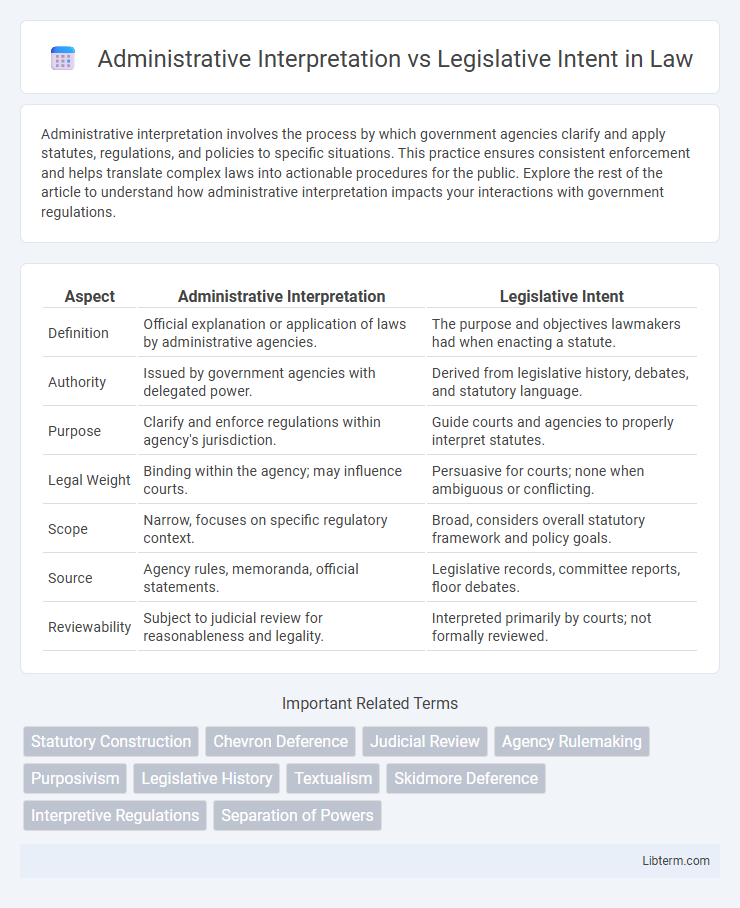Administrative interpretation involves the process by which government agencies clarify and apply statutes, regulations, and policies to specific situations. This practice ensures consistent enforcement and helps translate complex laws into actionable procedures for the public. Explore the rest of the article to understand how administrative interpretation impacts your interactions with government regulations.
Table of Comparison
| Aspect | Administrative Interpretation | Legislative Intent |
|---|---|---|
| Definition | Official explanation or application of laws by administrative agencies. | The purpose and objectives lawmakers had when enacting a statute. |
| Authority | Issued by government agencies with delegated power. | Derived from legislative history, debates, and statutory language. |
| Purpose | Clarify and enforce regulations within agency's jurisdiction. | Guide courts and agencies to properly interpret statutes. |
| Legal Weight | Binding within the agency; may influence courts. | Persuasive for courts; none when ambiguous or conflicting. |
| Scope | Narrow, focuses on specific regulatory context. | Broad, considers overall statutory framework and policy goals. |
| Source | Agency rules, memoranda, official statements. | Legislative records, committee reports, floor debates. |
| Reviewability | Subject to judicial review for reasonableness and legality. | Interpreted primarily by courts; not formally reviewed. |
Understanding Administrative Interpretation
Administrative interpretation involves agencies applying and clarifying statutes within their regulatory authority, emphasizing practical implementation over abstract legislative purpose. This process grants agencies discretion to interpret ambiguous legal provisions based on expertise and policy objectives, often shaping how laws function in practice. Understanding administrative interpretation requires recognizing its role in filling statutory gaps and adapting legislative mandates to evolving circumstances while maintaining adherence to the statutory framework.
Defining Legislative Intent
Defining legislative intent involves interpreting the purpose and objectives that lawmakers aimed to achieve when enacting a statute. It relies on analyzing legislative history, committee reports, and statutory language to clarify ambiguous provisions. Administrative interpretation differs by reflecting how agencies implement and enforce laws based on practical experience and expertise.
Core Differences Between Administrative Interpretation and Legislative Intent
Administrative interpretation involves how government agencies apply and enforce laws based on regulatory expertise, reflecting practical implementation within legal frameworks. Legislative intent centers on the original purpose and objectives lawmakers had when drafting and enacting statutes, often gleaned from legislative history and debates. The core difference lies in administrative interpretation adapting laws to specific cases and evolving conditions, while legislative intent seeks to preserve the statute's original meaning and policy goals.
The Role of Agencies in Administrative Interpretation
Agencies play a crucial role in administrative interpretation by applying legislative statutes to specific cases, which helps clarify ambiguous or broad laws. Their expertise enables them to fill in gaps and provide practical guidance that legislative intent alone may not fully address. Courts often defer to these agency interpretations under the Chevron doctrine, recognizing agencies' specialized knowledge in complex regulatory matters.
Legislative Intent: Origins and Importance
Legislative intent originates from the purpose and objectives lawmakers aim to achieve through statutes, reflecting the will of the legislative body during the law's enactment. Understanding legislative intent is crucial for courts and agencies to interpret laws consistently with the legislature's goals, ensuring statutory provisions are applied as intended. This principle helps resolve ambiguities in legal texts by focusing on the broader context and underlying objectives, rather than solely on the literal wording.
Judicial Approaches to Resolving Conflicts
Judicial approaches to resolving conflicts between administrative interpretation and legislative intent emphasize deference principles such as Chevron and Skidmore doctrines, where courts assess the reasonableness and consistency of agency interpretations with statutory language. Courts prioritize legislative history and purpose when statutory text is ambiguous or silent, ensuring that administrative interpretations do not contravene clear congressional mandates. When conflicts arise, judges balance respect for agency expertise with strict adherence to legislative intent, often invalidating administrative rules found to exceed statutory authority.
Case Studies Highlighting the Distinction
Case studies reveal that administrative interpretation often emphasizes practical application and agency expertise, as seen in Chevron U.S.A., Inc. v. Natural Resources Defense Council, where courts defer to agency interpretations of ambiguous statutes. In contrast, legislative intent is highlighted in cases like Church of the Holy Trinity v. United States, where courts prioritize the broader purpose and historical context of the law over literal statutory language. These distinctions illustrate how judicial review balances deference to administrative agencies with ensuring adherence to the legislature's original objectives.
Impact on Policy Implementation
Administrative interpretation shapes policy implementation by allowing agencies to adapt statutory mandates to practical realities, often filling gaps left by legislative text. Legislative intent provides the foundational purpose behind laws, guiding courts and agencies to enforce policies as originally envisioned by lawmakers. The dynamic tension between these concepts influences consistency, flexibility, and effectiveness in executing public policy.
Challenges in Balancing Administrative and Legislative Perspectives
Balancing administrative interpretation with legislative intent presents challenges in ensuring regulatory clarity while respecting the original purpose of laws. Courts often struggle to defer to administrative expertise without undermining legislative authority, creating tension between flexible rule application and strict statutory adherence. This dynamic requires ongoing dialogue to harmonize evolving policy objectives with the foundational intent expressed by lawmakers.
Implications for Legal Practice and Governance
Administrative interpretation shapes the application of laws by government agencies, influencing regulatory compliance and enforcement strategies critical for legal practitioners. Legislative intent clarifies the lawmaker's purpose, guiding courts in statutory interpretation and impacting judicial outcomes that affect governance policies. Understanding the distinction enhances legal accuracy, ensuring robust governance through precise application and development of the law.
Administrative Interpretation Infographic

 libterm.com
libterm.com